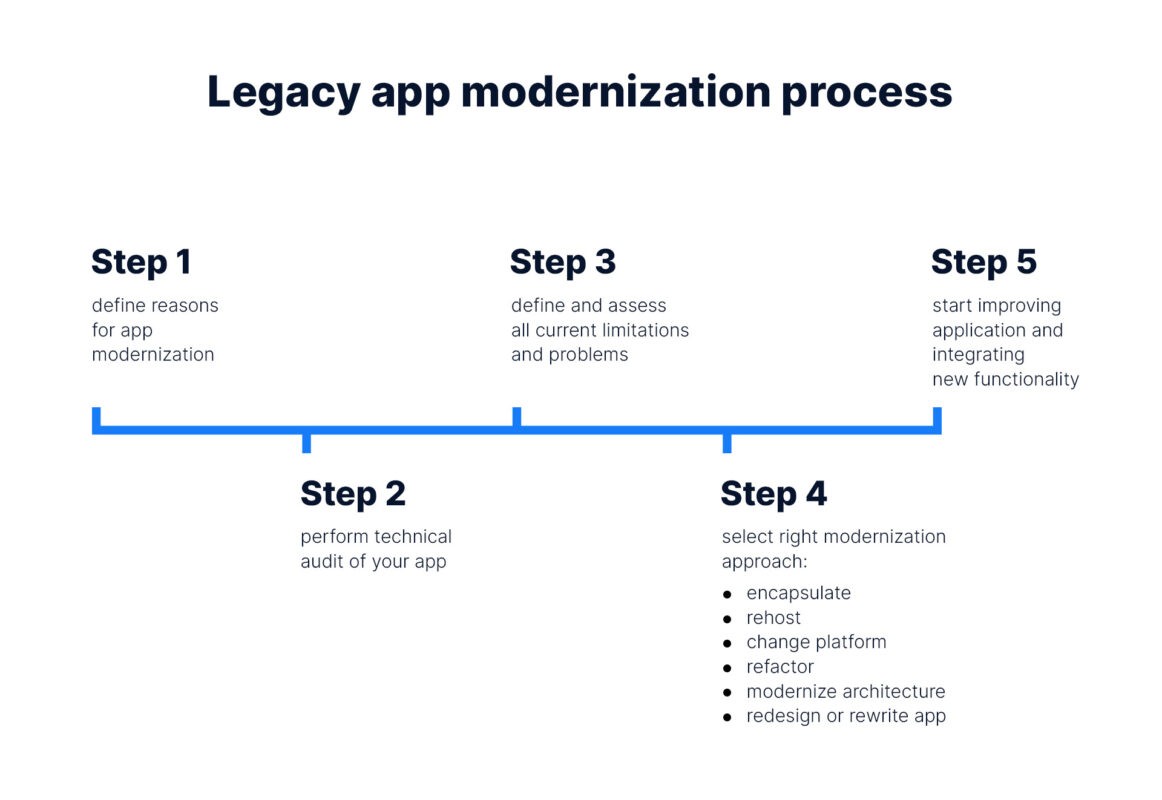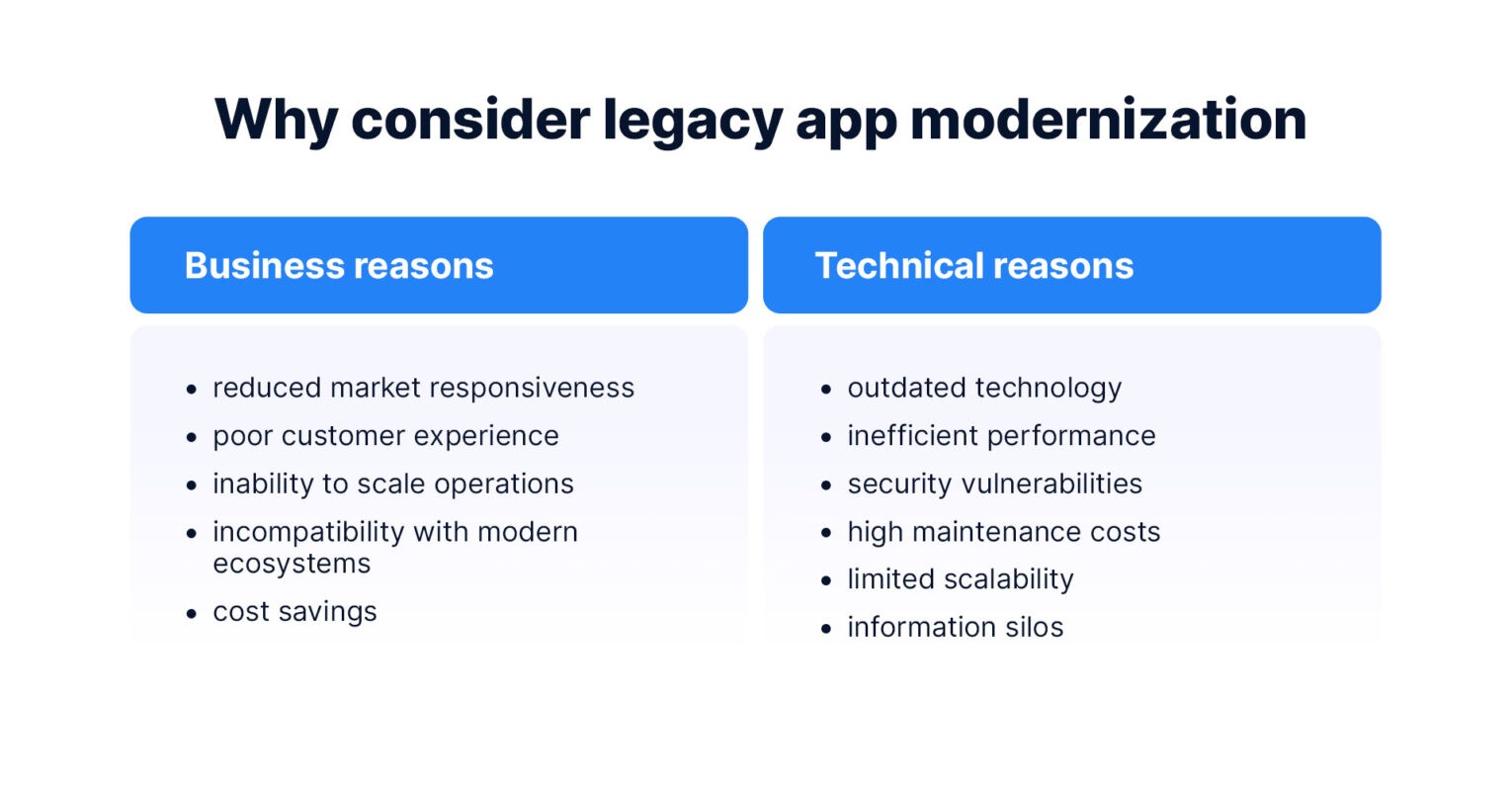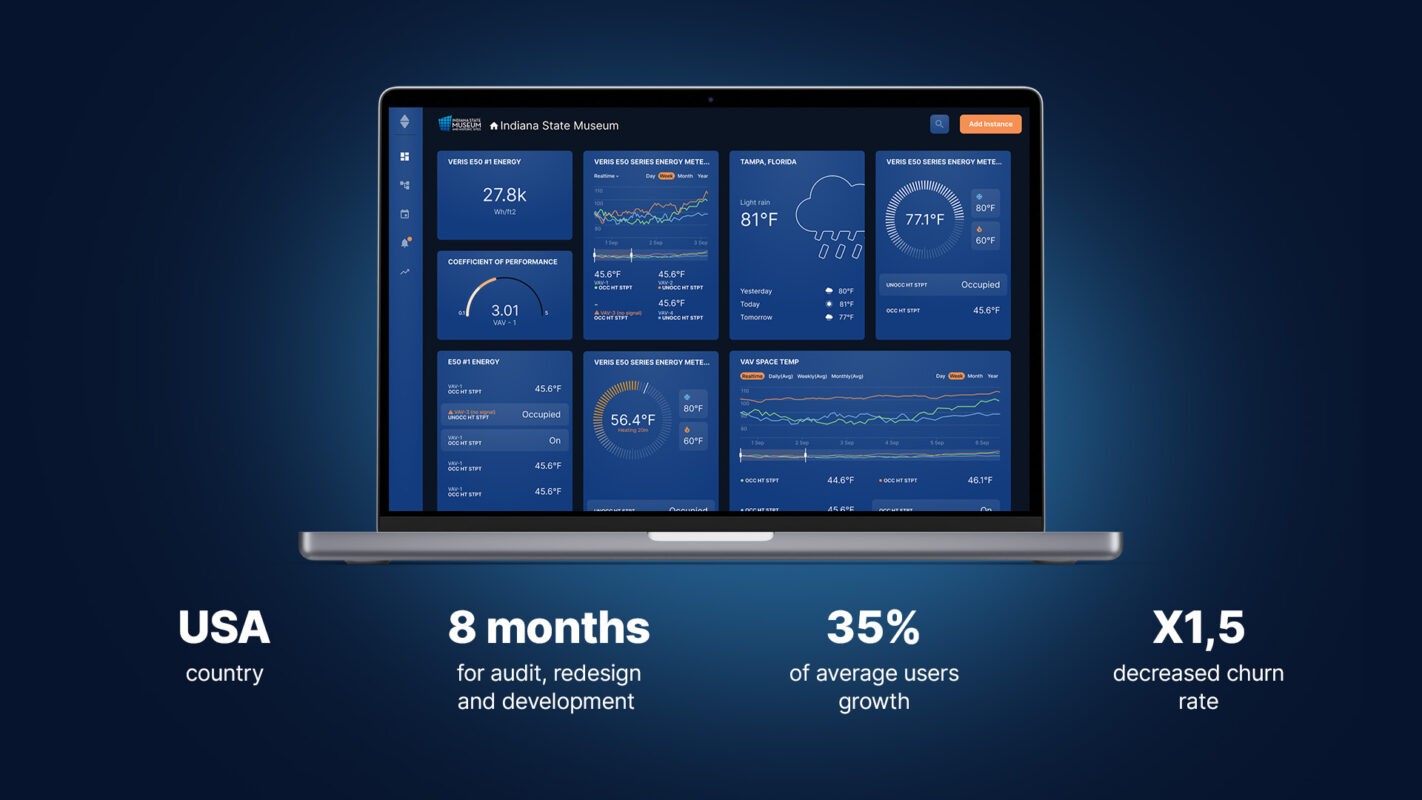
January 05, 2025
Legacy App Modernization: Go-to Guide from the Artkai Team
Legacy systems are outdated software, technology, or processes that are expensive to maintain and require significant effort to keep them running efficiently. An app becomes outdated when it can't meet important business needs anymore. When this happens, companies face a challenging decision: keep supporting the legacy product, update existing systems, or switch to something else.
As your apps and systems get older and become legacy systems, you'll run into common problems like:
- It's hard to keep them working properly.
- The existing code gets too big and messy.
- Integrations can be easily hacked.
- Legacy applications don't work well with other apps.
- They're slow and don't perform well.
- There's a risk of security problems and not following the rules.
- They can't handle new tasks and workflows.
- Customers don't have a good experience with outdated systems.
Where should you start with product modernization
To detect problems with their product and update it, we recommend our clients conduct an audit of their business processes. Business analysis also reviews business processes and market requirements for the product. You need to outline advanced technology aligned with current and future business strategies to remain competitive, efficient, and responsive to a dynamic market environment.
In case businesses experience technical problems and limitations, it’s better to conduct a technical audit for code and technical aspects. It includes researching and identifying technical issues and bottlenecks.
Depending on the results of the audit, the following reasons may already be revealed:
1) business problems and their risks
2) technical problems and their risks

Top business and technical reasons to perform product modernization
From our experience, these are the most popular reasons why businesses need modernizing legacy systems:

- Reduced Market Responsiveness - Legacy systems can hinder the company's ability to adapt quickly to market changes, digital transformation, or regulatory demands. This lack of agility may lead to a loss of competitive advantage and possible penalties for non-compliance.
- Poor Customer Experience - Outdated software and applications often lack the seamless and intuitive user experience expected by modern consumers. This can result in decreased customer satisfaction, reduced loyalty, and a decline in market share.
- Inability to Scale Operations - Legacy systems may constrain a company's ability to scale efficiently, hindering growth opportunities. This limitation can prevent businesses from capitalizing on new prospects and expanding their market presence.
- Incompatibility with Modern Ecosystems - Difficulty integrating with contemporary solutions and modern platforms can render legacy systems obsolete, limiting their effectiveness in the current technological landscape.
- Cost Savings - Implementing modernization strategies can lead to significant cost savings for businesses. However, the specifics of these potential savings depend on the unique circumstances of each organization and should be carefully evaluated.
As for the technical problems, the most prominent are the following:
- Outdated technology - Legacy applications often rely on outdated technology, which means they were built using older tools and systems. These outdated technologies can make them incompatible with modern standards and best practices.
- Inefficient performance - Outdated systems might suffer from inefficiencies and slow response times that hinder productivity.
- Security vulnerabilities - Due to outdated security measures and a lack of updates, legacy applications are more susceptible to cybersecurity threats.
- High maintenance costs - The need for ongoing maintenance and support for legacy applications can result in escalating costs over time.
- Limited scalability - Scaling these legacy systems to accommodate growing demands can be challenging and costly.
- Information Silos - Legacy code can be poorly written and annotated. This results in knowledge silos, which can be a huge strain on an organization when employees move on. Their successors may find it very hard to understand the code that’s been written, blocking the progress to making changes.
Depending on the audit’s results, the approaches to the modernization process differ. If it turns out that the code is outdated and difficult to maintain, we recommend to:
- Find out why the business wants to modernize legacy systems and what exactly stopped working with the code.
- Identify any limitations and problems, such as not working on new devices, expensive code support, lack of specialists to support the legacy software and tech stack, potential time-consuming feature additions, and the need to update outdated interfaces with modern architectures.
- Assess the problems with core functionality and understand which approach will suit us.
Choosing product modernization strategy
Artkai team uses 6 strategies for the product modernization process. Here they are:
- Encapsulate. Leverage and extend the application features by encapsulating its data and functions, making them available as services via an API. This approach ensures flexibility and scalability in integrating new functionalities.
- Rehost. Redeploy the application component to other infrastructure (physical, virtual, or cloud) without modifying its code, features or functions. This allows for seamless migration while maintaining system integrity.
- Change platform. Migrate to a new runtime platform, making minimal changes to the code but not the code structure, features or functions. This strategy enables the adoption of more advanced and new technologies without compromising system stability.
- Refactor. Restructuring and optimizing existing code (although not its external behavior) helps remove technical debt and improve nonfunctional attributes. This helps improve system performance and maintainability over time.
- Architecture modernization. Materially alter the code to shift it to a new application architecture and exploit new and better capabilities. This approach ensures alignment with evolving technological trends and business operations.
- Complete rebuild. Redesign or rewrite the application component from scratch while preserving its scope and specifications. This comprehensive approach allows for the creation of a more robust and scalable solution tailored to current business needs.
By employing these strategies, Artkai’s development team ensures efficient and effective modernization of client products, meeting evolving market demands, digital transformation, and technological advancements.
Top 4 benefits of legacy application modernization
At Artkai, we’ve observed that modernization is not necessarily about replacing legacy applications entirely, but rather about revitalizing them to meet contemporary needs and standards. Modernizing legacy applications is a future proof that offers a multitude of advantages for organizations seeking to remain competitive and efficient.
Here are the most frequent benefits businesses can get:
- Improved performance and efficiency of legacy apps - Legacy software modernization can significantly enhance the performance and operational efficiency of legacy software. As a result, you will get quicker response times and improved user experience.
- Enhanced security and compliance - Upgrading security measures and ensuring compliance with industry standards are integral components of modernization and data protection. Doing so helps reduce the risk of security vulnerabilities, data breaches, and avoid costly compliance issues.
- Better user interface and experience (UI/UX) - Modernization often involves revamping the user interface and user experience, which increases customer and employee satisfaction.
- Cost savings - Through legacy software modernization, businesses can reduce maintenance and operational costs, optimize infrastructure, and make new feature development more cost-effective, leading to substantial funds savings for businesses in the long run.
How product modernization pushed our client’s business to a new level
KMC Commander, a leader in IoT solutions, sought to modernize its platform with Artkai's expertise. Artkai's approach began with a thorough assessment, followed by UI/UX enhancements, performance optimization, and scalability improvements.
The project spanned 8 months for research and UX/UI design phase and 12+ months for development. Our development team leveraged modern technologies such as Microservices, Vue, AWS, GraphQL, PostgreSQL, etc. Artkai's strategic tech decisions, including architectural changes and robust monitoring systems, contributed to the platform's success in meeting performance, scalability, and reliability goals.
As a result, KMC Commander serves as a robust foundation for a modern smart building ecosystem, facilitating energy optimization, operational efficiency, occupant comfort, and safety. Our development team improved the platform with open protocol communication, intuitive dashboards, out-of-the-box system capabilities, and extensive scalability. It also offers comprehensive security measures from edge to cloud.

The platform now seamlessly integrates with building systems, offering facilities managers features like indoor air quality visualization, data collection, scheduling, history tracking, and security enhancements. Its well-designed system has facilitated partnerships with 150 industry leaders, including Intel and Amazon. Notably, KMC Commander has experienced a 35% increase in average users and a 1.5x decrease in churn rate.
Conclusion
Legacy system modernization is a critical process for businesses that want to stay competitive and efficient in today's dynamic market. We recommend to assess current applications, identify business and technical problems, and choose appropriate modernization strategies.
Starting with a technical audit and business analysis helps businesses understand the root causes of legacy software issues and plan effective modernization implementation of their legacy apps. Artkai’s development team uses six strategies for product modernization to address diverse challenges, ensuring efficient and effective transformations to modern systems.
Legacy application modernization brings numerous benefits, including improved performance, enhanced security, better user experience, and cost savings. The success story of KMC Commander demonstrates how strategic modernization efforts can take a business to new heights, enabling growth, market expansion, and increased profitability.
By embracing legacy system modernization and leveraging Artkai's expertise, businesses can overcome legacy system challenges, adapt to evolving market demands, and thrive in today's competitive landscape. If you need our expert consultation about legacy application modernization for business growth, contact us here.
Clients and Results
Schedule your free consultation
Don't miss this opportunity to explore the best path for your product. We are ready to delve into the specifics of your project, providing you with expert insights and optimal solutions.
Book your free sessionRead More
Explore articles from Artkai - we have lots of stories to tell
Join us to do the best work of your life
Together we advance the human experience through design.